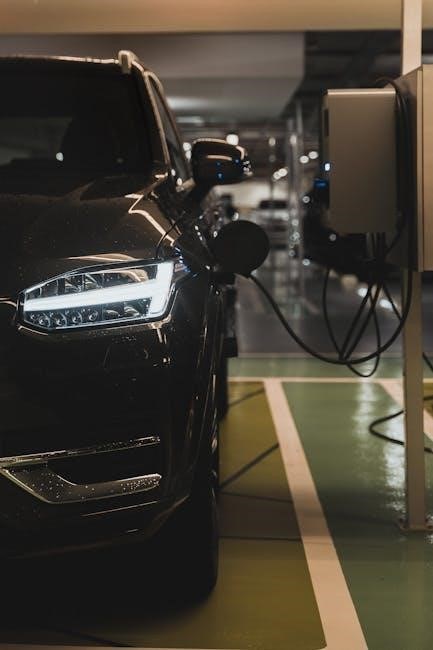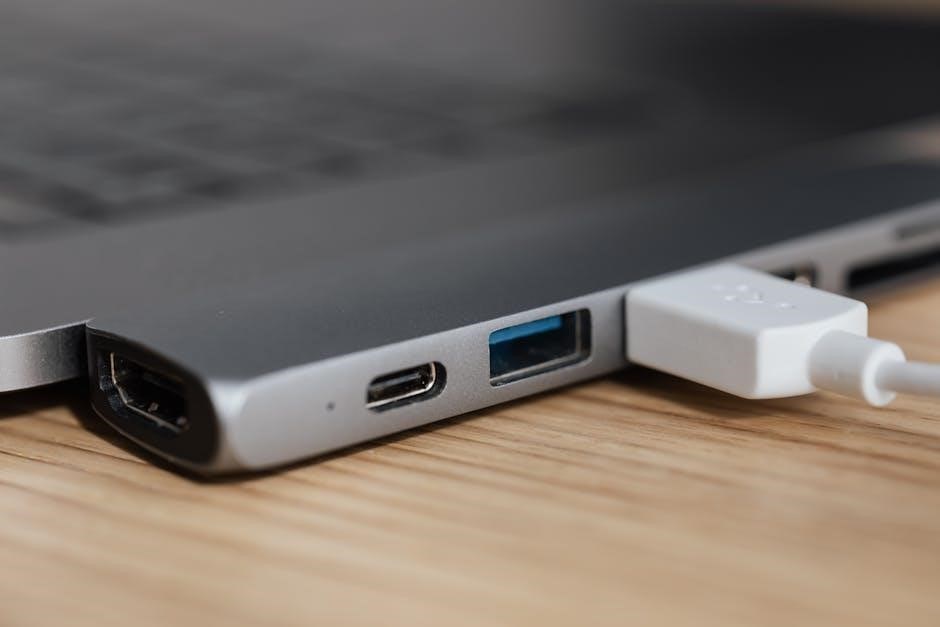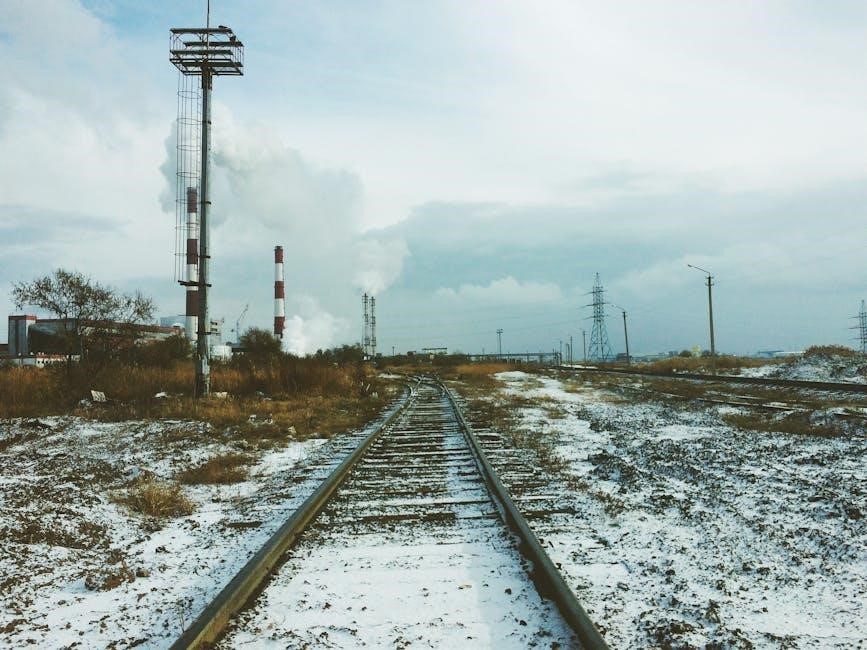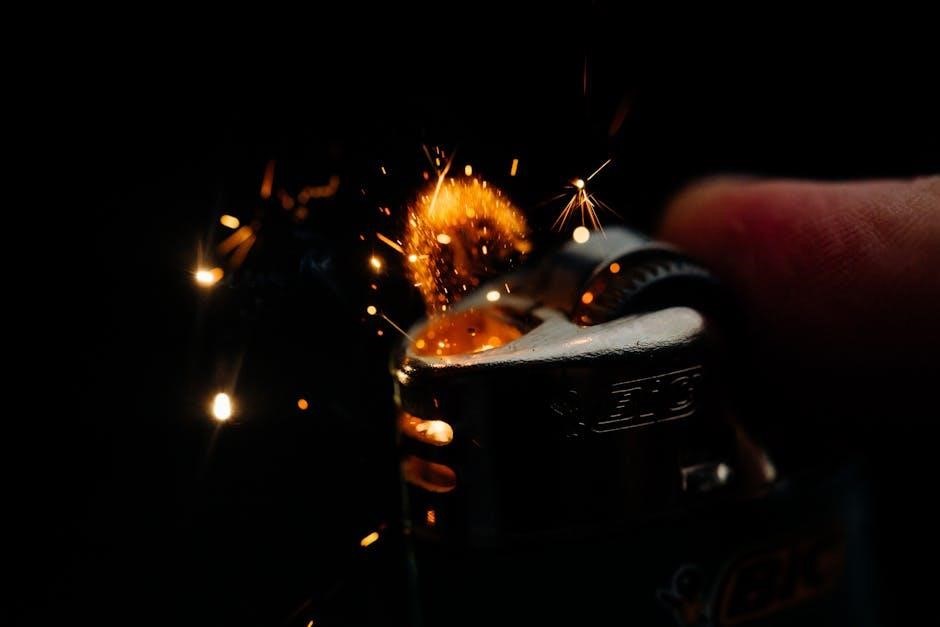cat 3 in 1 power station manual
The Cat 3 in 1 Power Station is a multi-functional energy solution designed for versatility and efficiency‚ catering to various industrial and construction needs with innovative technology․
1․1 Overview of the Cat 3 in 1 Power Station
The Cat 3 in 1 Power Station is an innovative‚ multi-functional energy solution designed to meet diverse power needs across industries․ It combines three essential power functions into one compact system‚ ensuring efficiency and versatility․ This power station is tailored for construction‚ mining‚ and industrial applications‚ offering reliable performance in demanding environments․ With a focus on durability and safety‚ the Cat 3 in 1 Power Station is engineered to withstand harsh conditions while delivering consistent energy output․ Its design emphasizes ease of operation and maintenance‚ making it a practical choice for professionals seeking a robust power solution․ As part of Caterpillar’s commitment to innovation‚ this product exemplifies the company’s legacy of providing high-quality equipment for global industries since 1925․ Its versatility and reliability make it a cornerstone for modern energy requirements․
1․2 Key Features of the Multi-Purpose Power Station
The Cat 3 in 1 Power Station boasts an array of key features that enhance its functionality and efficiency․ It incorporates a robust design‚ ensuring durability in challenging environments‚ and is built with high-quality components that meet Caterpillar’s stringent standards․ The power station offers three primary power solutions in one unit‚ reducing the need for multiple systems and streamlining operations․ Its advanced control panel provides intuitive monitoring and operation‚ while safety features such as overload protection and automatic shutdown safeguard both the equipment and users․ The system is also designed for low emissions and energy efficiency‚ aligning with environmental regulations․ Additionally‚ its compact footprint and mobility options make it ideal for various industrial and construction sites․ These features collectively ensure that the Cat 3 in 1 Power Station delivers reliable‚ versatile‚ and efficient power solutions for diverse applications․
1․3 Intended Use and Applications
The Cat 3 in 1 Power Station is designed for use in construction‚ mining‚ and industrial settings‚ offering versatile power solutions to meet diverse operational needs․ It serves as a reliable energy source for powering machinery‚ tools‚ and equipment in remote or challenging environments․ Its three-in-one functionality allows it to adapt to various tasks‚ such as generating electricity‚ providing hydraulic power‚ and enabling air compression‚ making it an essential tool for multi-tasking operations․ This multi-purpose design reduces the need for multiple separate systems‚ enhancing efficiency and streamlining workflows․ The power station is particularly suited for applications requiring flexible and adaptable energy solutions‚ where durability and performance are critical․ Its use extends to supporting infrastructure development‚ emergency power supply‚ and maintaining continuous operations in demanding conditions․

Safety Precautions and Guidelines
Ensure proper installation‚ operation‚ and maintenance to prevent hazards․ Use genuine parts and follow Caterpillar’s safety guidelines for optimal performance and user protection․
2․1 General Safety Considerations
Safety is paramount when operating the Cat 3 in 1 Power Station․ Always adhere to the manufacturer’s guidelines and industry standards to ensure safe operation․ Proper installation‚ regular maintenance‚ and the use of genuine Caterpillar parts are essential to prevent malfunctions․ Operators must be trained and aware of potential hazards‚ such as electrical risks or equipment overload․ Ensure the power station is installed in a well-ventilated area‚ away from flammable materials․ Regular inspections of cables‚ connectors‚ and components are crucial to identify and address wear and tear․ Never exceed the recommended load capacity‚ as this can lead to system failure or injury․ Environmental factors‚ such as extreme temperatures or moisture‚ should also be considered to maintain optimal performance and safety․ Always follow emergency shutdown procedures in case of anomalies․ Caterpillar’s commitment to safety and reliability ensures the power station operates efficiently when proper precautions are taken․
2․2 Handling and Storage Safety Tips
Proper handling and storage of the Cat 3 in 1 Power Station are critical to ensure longevity and safety․ Always use appropriate lifting equipment‚ such as cranes or forklifts‚ to avoid damage or injury․ Ensure the power station is placed on a stable‚ level surface during transportation and storage․ Store the unit in a clean‚ dry‚ and well-ventilated area‚ protected from extreme temperatures and moisture․ Avoid exposing the power station to direct sunlight or corrosive substances․ Disconnect batteries and drain fluids before long-term storage to prevent corrosion or leakage․ Use only genuine Caterpillar parts for replacements to maintain performance and safety․ Secure the unit to prevent accidental movement during transport or storage․ Regularly inspect the power station for signs of wear or damage before and after storage․ Follow all local regulations and guidelines for handling and storing electrical equipment to ensure compliance and safety․ Proper handling and storage practices will help maintain the integrity and functionality of the Cat 3 in 1 Power Station․
2․3 Environmental and Operational Safety
Ensuring environmental and operational safety is paramount when using the Cat 3 in 1 Power Station․ Always adhere to local environmental regulations and guidelines to minimize ecological impact․ Use eco-friendly materials and practices during operation and maintenance․ Properly dispose of waste‚ including batteries and fluids‚ to prevent contamination․ Regularly inspect emissions and ensure compliance with air quality standards․ Avoid operating the power station in hazardous environments‚ such as areas with flammable gases or liquids‚ to prevent accidents․ Use personal protective equipment (PPE) during operation and maintenance to safeguard against electrical and mechanical hazards․ Keep the unit away from water sources and wet conditions to avoid electrical risks․ Monitor noise levels to comply with local noise pollution standards․ Implement spill containment measures to protect soil and water․ Train operators on safe practices to ensure efficient and environmentally responsible use․ Caterpillar’s commitment to sustainability aligns with responsible operation of the Cat 3 in 1 Power Station․

System Components and Architecture
The Cat 3 in 1 Power Station features a robust design integrating a high-efficiency generator‚ advanced control panel‚ and modular components for scalable and reliable power solutions․
3․1 Major Components of the Power Station
The Cat 3 in 1 Power Station is comprised of several key components‚ each designed to deliver reliable and efficient power․ These include:
- High-Efficiency Generator: Produces stable and clean power for various applications․
- Advanced Control Panel: Features intuitive controls and monitoring systems․
- Modular Battery System: Ensures consistent energy storage and backup capabilities․
- Smart Inverter/Charger: Manages energy conversion and charging processes efficiently․
- Fuel System: Designed for optimal performance and fuel efficiency․
These components work together to provide a versatile and durable power solution‚ suitable for a wide range of applications and environments․
3․2 System Architecture and Design
The Cat 3 in 1 Power Station features a cutting-edge system architecture designed for seamless integration and optimal performance․ Its modular design allows for flexibility and scalability‚ catering to diverse power needs․ The power station incorporates a robust control system that ensures efficient energy management across all operational modes․ Key design elements include:
- Modular Architecture: Enables easy expansion and customization of power solutions․
- Centralised Control Unit: Manages power distribution‚ monitoring‚ and safety protocols․
- Redundant Systems: Provides backup capabilities to ensure uninterrupted power supply․
- Smart Energy Management: Optimises energy usage and minimises waste․
This design philosophy ensures the power station operates efficiently‚ reliably‚ and safely‚ making it suitable for both residential and industrial applications․
3․3 Integration of Multiple Power Solutions
The Cat 3 in 1 Power Station is designed to integrate multiple power solutions seamlessly‚ offering a versatile and adaptable energy system․ It combines solar‚ battery‚ and AC input power sources into a single‚ cohesive unit․ This integration allows for automatic switching between power modes‚ ensuring continuous energy availability․ The system’s advanced control logic optimises energy flow‚ prioritising renewable sources when available․ Key features include:
- Hybrid Power Management: Combines solar‚ battery‚ and grid power for reliable energy supply․
- Smart Load Management: Automatically adjusts power distribution based on demand․
- Seamless Transition: Switches between power sources without downtime or user intervention․
This multi-power integration enhances system reliability‚ efficiency‚ and scalability‚ making it ideal for various applications‚ from residential to industrial use cases․

Installation and Setup
This section outlines the installation and setup process for the Cat 3 in 1 Power Station․
Follow safety guidelines and manufacturer recommendations for site preparation‚ connections‚ and commissioning․
- Ensure all components are correctly aligned and securely fastened․
- Double-check all electrical connections for safety and efficiency․
- Refer to the manual for specific commissioning procedures․
4․1 Site Preparation for Installation
Proper site preparation is crucial for the safe and efficient installation of the Cat 3 in 1 Power Station․
Choose a flat‚ dry‚ and stable surface‚ ensuring the area is clear of debris and vegetation․
Check for overhead obstructions and ensure the site is accessible for maintenance․
Verify that the location complies with local building codes and regulations․
- Ensure the site is well-ventilated to prevent the accumulation of fumes or moisture․
- Mark the area to avoid accidental damage during installation․
- Prepare grounding points as specified in the manual to ensure electrical safety․
Failure to prepare the site correctly may lead to operational issues or safety hazards․
4․2 Electrical Connections and Wiring
Connecting the Cat 3 in 1 Power Station requires careful attention to electrical wiring to ensure safety and optimal performance․
Use high-quality‚ appropriately rated cables and connectors to prevent power loss or overheating․
Refer to the wiring diagram provided in the manual for precise connection points and configurations․
Ensure all grounding wires are securely attached to prevent electrical shocks or system malfunctions․
- Connect the main power supply to the designated input terminals‚ following polarity guidelines․
- Double-check all connections for tightness and integrity before powering up․
- Install surge protectors or circuit breakers to safeguard against voltage spikes or overload․
Test the system at low power to verify proper operation before full deployment․
4․3 Commissioning the Power Station
Commissioning the Cat 3 in 1 Power Station involves verifying its proper operation after installation․
Begin by powering up the system using the main control panel‚ ensuring all components are initialized․
Conduct a series of functional tests to validate electrical output‚ battery performance‚ and mode switching capabilities․
- Check the display panel for accurate system status and error messages․
- Test all ports and connectors to ensure proper power delivery to connected devices․
- Verify the system’s response to load changes and environmental conditions․
Document the results and perform final adjustments as needed to optimize performance․
Consult the manual for specific commissioning procedures and troubleshooting guidance if issues arise․
Once validated‚ the system is ready for full operational use․

Operational Modes and Controls
The Cat 3 in 1 Power Station offers multiple operational modes‚ including Eco and Turbo‚ managed via a digital control panel․ Users can monitor and adjust settings seamlessly․
5․1 Understanding the Control Panel
The control panel is the central interface for managing the Cat 3 in 1 Power Station․ It features an LCD display that provides real-time data on voltage‚ frequency‚ temperature‚ and battery levels․ The panel includes buttons for mode selection‚ a rotary knob for adjusting output settings‚ and LED indicators for system status․ Users can toggle between Eco‚ Standard‚ and Turbo modes‚ each optimizing performance for specific loads․ The display also shows error codes‚ guiding troubleshooting․ The control panel is designed for intuitive operation‚ with clear labels and a logical layout․ It allows users to monitor performance‚ adjust settings‚ and access advanced features like remote monitoring via Bluetooth or Wi-Fi․ Regularly checking the control panel ensures optimal operation and helps prevent potential issues․ Always refer to the manual for detailed explanations of symbols and functions․
5․2 Switching Between Power Modes
The Cat 3 in 1 Power Station offers three distinct power modes: Eco‚ Standard‚ and Turbo․ Eco mode prioritizes energy efficiency‚ ideal for low-power devices like lights or small electronics․ Standard mode balances performance and efficiency‚ suitable for everyday use with medium-sized loads․ Turbo mode delivers maximum power for high-demand appliances‚ such as power tools or large refrigerators․ Switching between modes is seamless via the control panel or remote interface․ The system automatically adjusts voltage and frequency to match the selected mode․ LED indicators on the control panel confirm the active mode‚ ensuring users are aware of the current setting․ This flexibility allows users to optimize energy use and performance based on their specific needs․ Always match the mode to the connected load to ensure safe and efficient operation․
5․3 Monitoring System Performance
Monitoring the Cat 3 in 1 Power Station’s performance is essential for optimal operation․ The system features a detailed control panel with real-time data displays‚ including voltage‚ frequency‚ and temperature levels․ Users can track energy output‚ input‚ and storage levels via the digital screen․ The control panel also provides alerts for overload‚ overheating‚ or low battery conditions‚ ensuring prompt intervention․ Additionally‚ the power station supports remote monitoring through a dedicated app‚ allowing users to check performance metrics and receive notifications via Bluetooth connectivity․ Regular monitoring helps maintain efficiency‚ prevent downtime‚ and extend the system’s lifespan․ Always ensure all readings are within recommended ranges for safe and reliable operation․

Maintenance and Servicing

Regular maintenance ensures optimal performance and longevity of the Cat 3 in 1 Power Station․ Schedule routine inspections‚ clean components‚ and replace wear-and-tear parts as needed․
6․1 Routine Maintenance Schedule
Adhere to a regular maintenance schedule to ensure the Cat 3 in 1 Power Station operates efficiently․ Check the battery charge level monthly and charge as needed․ Clean dust and debris from vents and surfaces every 30 days to prevent overheating․ Inspect cables and connections for damage or wear; replace any compromised components immediately․ Every 6 months‚ check the electrolyte levels in the battery (if applicable) and top up with distilled water․ Additionally‚ ensure all terminals are tight and free from corrosion․ For optimal performance‚ schedule an annual professional servicing to inspect internal components and address any potential issues before they escalate․ Always refer to the manual for specific instructions tailored to your model․
6․2 Replacement of Wear and Tear Parts
Replace wear and tear parts promptly to maintain the Cat 3 in 1 Power Station’s performance and longevity․ Common parts requiring replacement include the battery‚ fans‚ and connectors․ Inspect the battery every 6 months; replace it if capacity drops below 80%․ Fans may need replacement if they show signs of wear or reduced airflow․ Connectors should be replaced if they become loose or corroded․ Always use genuine or compatible replacement parts to ensure reliability․ Before starting any replacement‚ disconnect the power source and follow proper safety protocols․ Refer to the manual for specific instructions and torque specifications․ Keep a record of replacements to track maintenance history․ Regularly updating these components will help prevent unexpected failures and ensure consistent operation․
6․3 Electrical System Checks and Diagnostics
Regular electrical system checks are crucial for ensuring the Cat 3 in 1 Power Station operates safely and efficiently․ Start by inspecting all wiring and connections for signs of damage‚ wear‚ or corrosion․ Use a multimeter to verify voltage and resistance levels‚ ensuring they align with the specifications outlined in the manual․ Check circuit breakers and fuses to confirm they are functioning correctly․ Perform diagnostics on the inverter‚ battery management system‚ and charge controllers to identify any faults․ Monitor error codes displayed on the control panel and consult the troubleshooting guide for resolutions․ Test the grounding system to ensure proper electrical safety․ Always disconnect power before performing detailed inspections․ Document findings and address issues promptly to prevent system malfunctions․ Regular electrical checks help maintain reliability and extend the lifespan of the power station․

Troubleshooting Common Issues
This section provides step-by-step guidance for identifying and resolving common operational problems with the Cat 3 in 1 Power Station‚ ensuring efficient issue resolution and minimal downtime․
7․1 Identifying Common Operational Problems
The Cat 3 in 1 Power Station may encounter issues such as power fluctuations‚ overload conditions‚ or battery drainage․ Users should monitor for error codes‚ unusual noises‚ or uneven performance․ Common problems include faulty electrical connections‚ insufficient charging‚ or overheating․ Battery life degradation over time is natural but can be managed with proper maintenance․ Surge protection and voltage stability are critical to prevent damage․ Users should also check for software updates‚ as outdated firmware may cause operational inefficiencies․ Regular inspections of cables and ports can help identify worn or damaged components․ Keeping the unit in a cool‚ dry environment minimizes risks of malfunction․ For persistent issues‚ consulting the troubleshooting guide or contacting support is recommended․ Early detection of these problems ensures optimal performance and longevity of the power station․

7․2 Error Codes and Their Meanings
The Cat 3 in 1 Power Station displays specific error codes to indicate operational issues․ These codes help users identify and address problems quickly․ Common error codes include E01 (battery malfunction)‚ E02 (overload detection)‚ and E03 (temperature extremes)․ Each code corresponds to a specific issue‚ such as faulty electrical connections‚ overheating‚ or insufficient charge levels․ Understanding these codes enables users to take corrective actions‚ like reducing load‚ cooling the unit‚ or checking connections․ The manual provides a detailed list of codes and their meanings‚ ensuring users can diagnose and resolve issues efficiently․ Regularly reviewing error codes helps maintain system performance and prevents potential damage․ If an error persists‚ users should consult the troubleshooting guide or contact customer support for assistance․ This feature enhances reliability and user confidence in the power station’s operation․
7․3 DIY Repair and Service Tips
Performing DIY repairs on the Cat 3 in 1 Power Station can save time and extend its lifespan․ Start by ensuring the unit is powered off and cool before attempting any repairs․ Common DIY fixes include cleaning dust from vents‚ tightening loose connections‚ and replacing worn-out cables․ For battery issues‚ check terminal connections and ensure they are free from corrosion․ If the system fails to charge‚ inspect the AC adapter or DC input for damage․ Avoid overloading circuits‚ as this can cause permanent damage․ Always use genuine replacement parts to maintain performance and safety․ If a problem persists‚ consult the manual or contact customer support․ DIY repairs should only be attempted for minor issues‚ while major faults require professional servicing․ Regular maintenance‚ such as updating firmware and checking for software updates‚ can also enhance functionality․ Keep the unit in a dry‚ well-ventilated area to prevent moisture damage․ DIY servicing can be cost-effective but requires caution and adherence to safety guidelines․ Always refer to the manual for specific instructions before starting any repair․ If unsure‚ seek professional assistance to avoid further complications․ By following these tips‚ users can maintain their power station effectively and ensure optimal performance․

Appendices and Additional Resources
This section provides supplementary materials‚ including technical specifications‚ compliance documents‚ a glossary of terms‚ and references for further reading․ These resources support comprehensive understanding and maintenance of the Cat 3 in 1 Power Station․
8․1 Technical Specifications and Data Sheets
The technical specifications and data sheets provide detailed information about the Cat 3 in 1 Power Station’s performance‚ capacity‚ and operational parameters․ These documents outline the power output‚ battery capacity‚ charging methods‚ and compatibility with various devices․ Key specifications include voltage ratings‚ maximum power delivery‚ and efficiency levels․ The data sheets also list the dimensions‚ weight‚ and environmental operating conditions of the unit․ Additionally‚ they detail the types of ports and connectors available‚ such as USB-C‚ AC outlets‚ and DC sockets․ These resources are essential for understanding the product’s capabilities and ensuring proper usage․ Users can refer to these documents to verify compatibility with their devices and optimize performance․ The technical specifications are subject to change‚ so it’s important to consult the latest version provided by the manufacturer or supplier․
8․2 Compliance and Regulatory Information
The Cat 3 in 1 Power Station is designed to meet various international safety and environmental standards․ It complies with certifications such as UL (Underwriters Laboratories)‚ CE (Conformité Européene)‚ and FCC (Federal Communications Commission) standards‚ ensuring safe and reliable operation․ The product adheres to safety regulations for battery management‚ electrical output‚ and thermal performance․ Environmental compliance includes adherence to RoHS (Restriction of Hazardous Substances) and MSDS (Material Safety Data Sheet) guidelines․ The power station is also designed to meet electromagnetic compatibility (EMC) standards‚ minimizing interference with other electronic devices․ All compliance and regulatory information is documented in the appendices‚ including certification marks‚ reports‚ and compliance statements․ Users are advised to review this section to ensure the product meets local and regional regulations․ Regular updates to compliance information are provided by the manufacturer to reflect evolving standards and requirements․
8;3 Glossary of Terms and Definitions
This section provides definitions for key terms related to the Cat 3 in 1 Power Station to ensure clarity and understanding․ AC Output refers to the alternating current provided by the power station‚ suitable for devices like laptops․ DC Input denotes the direct current from sources such as solar panels or a car adapter․ The Inverter converts DC power to AC‚ enabling the operation of standard household appliances․ Battery Management System (BMS) monitors and controls battery performance‚ ensuring safety and efficiency․ Solar Charging involves harnessing sunlight to recharge the battery via photovoltaic panels․ Efficiency measures the percentage of energy effectively converted and used by the system․ These terms are essential for understanding the operation‚ maintenance‚ and troubleshooting of the Cat 3 in 1 Power Station‚ ensuring optimal performance and longevity․
8․4 References and Further Reading
For comprehensive understanding and additional insights‚ refer to the following resources:
Official Documentation: The Cat 3 in 1 Power Station manual‚ technical data sheets‚ and compliance certificates provide detailed specifications and operational guidelines․
Online Guides: Manufacturer websites and forums offer tutorials‚ FAQs‚ and user testimonials․
Technical Publications: Industry journals and white papers on portable power systems can deepen technical knowledge․
These resources ensure users can troubleshoot‚ optimize performance‚ and explore advanced features․ Always consult the latest versions for updates and compliance with safety standards․

